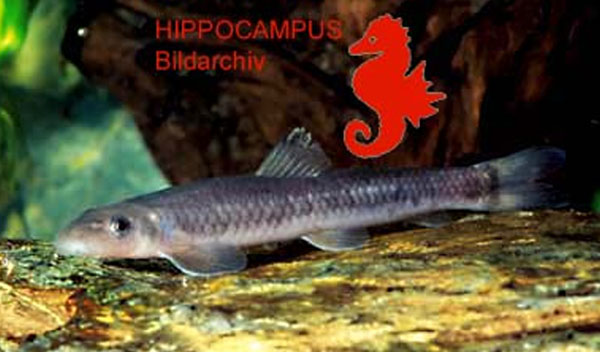| Cyprinidae (Minnows or carps), subfamily: Labeoninae |
| 7.2 cm SL (male/unsexed) |
|
benthopelagic; freshwater, |
| Africa: Niger basin to Congo River basin (Ref. 2801). |
|
Dorsal spines (total): 0-0; Dorsal soft rays (total): 10-10; Anal spines: 0-0; Anal soft rays: 7-8. Diagnosis: dorsal profile distinctly arched; rostral lobe well developed and edge very weakly denticulate (Ref. 81282). Suctorial disc development intermediate, with free posterior edge; post-pelvic region scaled, predorsal region partially scaled; belly and chest naked; predorsal length 45.5-52.2% SL; body depth 15.8-22.3% SL; head length 22.7-28.8% SL; (Ref. 81639). Scale formula: 4.5/35-38/-; 3.5; 14-16 (Ref. 81282) or 34-37 scales in lateral line and 12-14 circumpeduncular scales (Ref. 81639). D: III ,7; A: III, 5; P: IV, 11; V: II, 6 (Ref. 81639) or D: III,7; A: II,5; P: I, 14; V: 8 (Ref. 2940, 81282).
Description: rostral lobe well developed, very fleshy, with a slightly denticulate edge; lower lip forming a nearly smooth mental disk with a free marginal membrane (Ref. 81282). No tubercles on the snout (Ref. 81639). Two pairs of very short barbels (Ref. 81282). Vent is located away from the anal fin; distance from vent to anal fin is 25.4-39.1% of the distance between origins of anal and pelvic fins (Ref. 81639).
Coloration: dark brown dorsally, belly light yellow; several black spots at the base of the dorsal fin (Ref. 2940, 81282, 81639); a small dark spot just behind opercule at the beginning of the lateral line; a rather indistinct longitudinal band on sides (Ref. 81282). |
| Maximum recorded TL: 8.5 cm (Ref. 2801). |
|
Least Concern (LC); Date assessed: 06 May 2019 Ref. (130435)
|
| harmless |
Source and more info: www.fishbase.org. For personal, classroom, and other internal use only. Not for publication.

